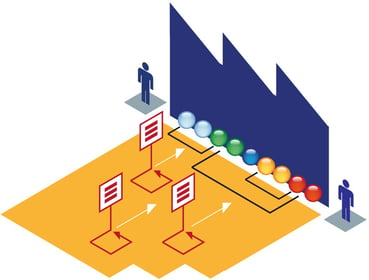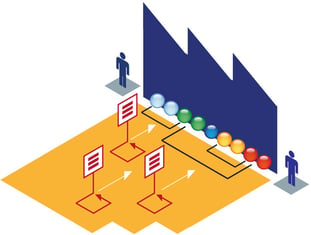5 Steps Toward Successful S&OP
Brian Hoey - August 13, 2019

 Supply and demand are the first two concepts that most people learn about with regard to economics—and they’re also two of the most crucial elements of any manufacturing supply chain. In order to effectively meet customer demand, you need to ensure that you have enough supply on hand; and in order to profit by that demand, you have to make sure that your supply doesn’t wildly exceed your needs. As with so many things in manufacturing, this is easier said than done.
Supply and demand are the first two concepts that most people learn about with regard to economics—and they’re also two of the most crucial elements of any manufacturing supply chain. In order to effectively meet customer demand, you need to ensure that you have enough supply on hand; and in order to profit by that demand, you have to make sure that your supply doesn’t wildly exceed your needs. As with so many things in manufacturing, this is easier said than done.
For many modern manufacturers, sales and operations planning, or S&OP, seems like the best option for creating alignment between these two critical forces. Why? Because it enables planners to focus on improving forecasts and leveraging them into longer term operational strategies—improving order fulfillment and increasing both agility and efficiency in the process. The question is: how do you successfully implement S&OP workflows in your manufacturing outfit?
1. Identify the Right People
S&OP is, on the one hand, deeply rooted in technology—it’s most effective when it’s powered by things like advanced predictive analytics. At the same time, however, it’s equally deeply rooted in collaboration, meaning that before you get down to the technological nitty-gritty, you need to make sure that your processes involve the right stakeholders, and that those stakeholders are sufficiently invested and empowered. Because S&OP is such a wide-reaching concept, you’ll want to find representatives from sales, marketing, purchasing, production planning, IT, etc. In each quarterly meeting, they should be prepared to share data from the previous months and align on strategy, incentives, and a larger operation outlooks. This lays the groundwork for a shift away from off-the-cuff decision making in those unfortunate moments where demand and supply don’t match up correctly.
2. Ensure Visibility
Of course, in order for each of the department representatives to provide appropriate data, you’ll have to make sure that it’s possible for everyone within your organization to access the data they need when they need it. If a production planner wants to see what a given facility’s throughput has been for the past month, she should be able to do so with a few clicks. Likewise, if your sales team needs to be able to examine recent customer orders, there should be a simple process in place for doing so. While we described the process of collecting stakeholders above as being a collaborative problem, visibility itself is almost always a technological problem. In an old-school planning environment that relies on pen and paper or spreadsheets for record keeping and documentation, you’re likely to encounter information silos that will make effective forecasting and stakeholder alignment difficult or impossible. Conversely, if you’re operating in a Postmodern ERP environment, in which each function’s IT integrates with that of each other function, you’ll have the kind of data rich processes that are so crucial to successful S&OP.
3. Establish Benchmarks
By finding the right people and making data accessible to them as needed, you lay the groundwork for successful S&OP processes. From there, you can move on to the actual implementation. This, too, begins with data. For starters, you’ll need to establish benchmarks for how your business is currently performing on the tasks that relate to S&OP. Ask yourself: how accurate have your forecasts been historically? What do your supply levels look like and how do they fluctuate over time? What is the exact relationship between raw materials and finished products? How long does it typically take to fulfill an order? How large is your buffer stock and how often do you find yourself dipping into it? Once these benchmarks have been established and made visible intra-operationally, you can select one or more KPIs to focus on and then measure your future efforts against these initial reports.
4. Put Theory Into Practice
Once you’ve selected the KPIs that you're going to focus on, it’s time to take steps to address it. By the very nature of S&OP processes, this is generally going to begin with improving your forecasts. Luckily, you’ve made data more accessible to key stakeholders throughout your organization, meaning that you’ll have enough data to break the stranglehold of reliance on past events for guiding future plans. Since your attempts at visibility were likely based in digital technology, your predictions and plans should be as well—you might, for instance, use advanced analytics algorithms to analyze your existing demand data to create estimates of future demand levels that no human planner could realistically create on his own. If, for instance, these new forecasts are 15-20% more accurate than manually created forecasts (to take an extremely conservative example), you’re in a position to increase efficiency by roughly that much. How? By adjusting your raw material orders, buffer stock, and capacity accordingly. Again, this is simultaneously a technological and an operational problem, meaning that the very elements that enable you to create smarter forecasts and more optimal production plans will also, ostensibly, provide you with the cross-functional agility to put those plans into action and change course as needed.
5. Bridge the Planning Gap
Often, a business will implement many of the elements we discussed above, establish S&OP as a major pillar of their corporate strategy, and declare victory. And they’re absolutely right to do so—but that doesn’t mean there’s nowhere to go from successful S&OP deployment. Given the level of technology integration already required, you might consider ramping up to real-time data from various touchpoints on your supply chain. This would enable you do develop a sales and operations execution (S&OE) workflow to bridge the gap between quarterly operations planning and day-to-day supply chain activities. S&OE planners would be tasked with taking a daily supply chain snapshot and making minute adjustments to stock levels and transport plans in order to match supply and demand in a dynamic, ongoing way. In so doing, companies not only gain an ongoing window into how S&OP plans are actually playing out in the real world—they also put safeguards in place for preventing small deviations from your forecasts from cascading into larger disruptions. This process will, of course, be easier for businesses that are trending more in the direction of Industry 4.0-readiness, but the value S&OE can have for bolstering your S&OP processes is hard to exaggerate.
LATEST POSTS
- Understand Why Production Planning Needs Specialized Solutions
- Understand Circular Economy in The Manufacturing Industry
- How Can Industry 4.0 IT Integration Be Achieved Smoothly?
- The Significance of Order Sequencing in Discrete Manufacturing
- How to improve your Supply Chain Management: The Power of Control Towers



